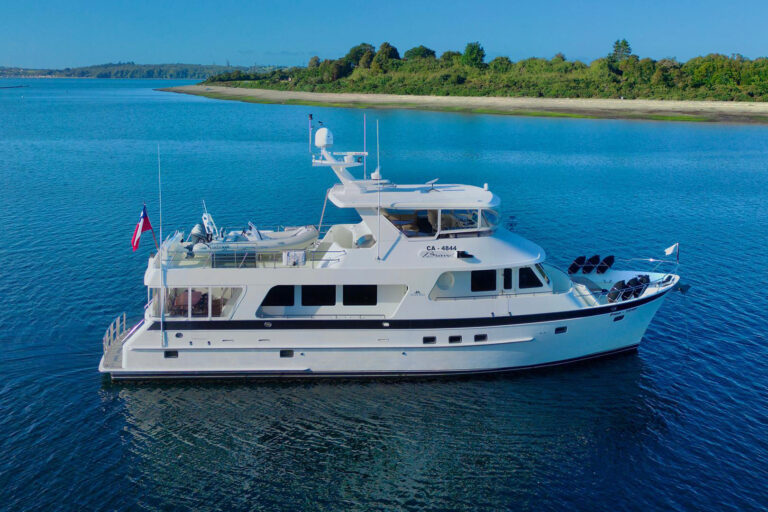
yachting/images/magazine/2007/042007/fea_hampton2_550x176.jpg
At first glance, boat tests seem to be about, well, boats. But the reality is that boat tests are about people. That’s because people make the design decisions, people build the boats, people sell the boats and, you guessed it, people buy the boats. Just as no boat springs into existence fully grown like Venus in the famous Botticelli painting, popping out of a scallop shell in seafoam, every yacht is the culmination of thousands of personal decisions, some large and some small, with each molding the personality of that vessel.
Case in point: our test of the Hampton 630 Pilothouse. Forest Roberts-that’s Captain Forest Roberts-bounds out of his office, all crisp cargo shorts and starched shirt and radiating energy. “Can’t wait to show ya what we’re doing with Hampton here at Anchor Yachts, he says, and hustles me outside to their dock on Ft. Lauderdale’s Marina Mile.
From this point on for several hours through our boat test, it’s a fascinating and thought-provoking look behind the scenes at how this dealer for Hampton Yachts specs, fits out and delivers his yachts.
Before I’m even out of the office, Roberts is showing me the first example of what I will come to know as “the Anchor way, handing me plugs drilled from the Hampton hull at various points. “See, he says, “Anchor orders three layers of Kevlar in the bow, two layers of Kevlar throughout the hull to the top of the hull sides, and a collision bulkhead forward. You’d have to hit something damn hard to hole this hull, he says, smacking his fist for emphasis. Add to that a Divinycell-reinforced house with vinylester resins, and you have a rugged package.
This particular 630, hull number five, is about to be delivered to its new owner in Charleston. When I ask about options on this boat, Roberts grins. “There are only three options on our list: dinghy, watermaker and satellite TV. Everything else is turnkey.
“Our goal, he continues, “is to make buying a Hampton seamless. We take the Lexus approach: we install all the gear on the boat that clients want and need. We don’t believe in long option lists just to keep the base price low, and we put a lot of thought and research into how everything should work together rather than being a lot of afterthoughts tacked together.
A phone rings and Roberts picks it up. It turns out that another of the “Anchor touches is a Panasonic intercom/land phone/cell link that allows you to “dock your cell phone when you step aboard, and answer it at any phone in any cabin.
It also quickly becomes apparent that Anchor Yachts also likes redundancy: There are two of everything important on board. We haven’t even gotten past the huge lazarette, and I’m being shown the twin Cablemaster reels (standard) that are backed up by two shore-power connectors forward (also standard for bow-in docking) and all leading to a pair of IsoBoost transformers (standard, of course).
There are twin steering pumps (full power steering even with one engine down), two VHF radios (which makes monitoring both bridge and ship-ship frequencies easy), two hydraulic power take-offs on the 850 hp Cat diesels (one alone can handle normal loads), twin generators, two GPS antennae (with a switchover), Wesmar stabilizers (with extra cooling pumps), and water pumps on each engine that cross-cool both prop shafts. Up top are two helm chairs facing a dual-panel Raymarine dashboard.
If this sounds like the sort of systems you’d find on a serious commercial workboat, you’d be right. But when you step through the stainless steel sliding doors into the Hampton saloon, this is pure yacht from the supple leather seating to the beveled glass china cabinet. The wood is makore, which is an African cherry; it has the warmth of cherry but is marked by stripes that are perfectly matched under a high-gloss finish.
The windows are large enough to see out of while seated on either the couch with its chaise-like end or on the two barrel chairs. There’s a wet bar with fridge and hidden sink, a flat-screen TV in the forward bulkhead surrounded by curio cabinets and stylish wood-slat blinds. An interesting point is that the 630 is based on the same hull as the Hampton 680, but the house is actually wider than the one on the larger yacht. This translates into considerably more space inside the saloon of the 630 and the good news is that it doesn’t cramp the walk-around side decks, either.
Just forward and up is the pilothouse, which, with the galley aft and a big granite-topped settee to port, is a comfy gathering place under way. As with everything on this boat, the galley gear has been chosen for easy maintenance with GE Profile appliances, a big Fisher Paykel dishwasher and a Broan compactor.
The skipper gets the place of honor in the pilothouse with a black leather Pompanette helm chair (electrically operated) and a burled dash full of Raymarine electronics: radar, GPS, chartplotter, etc. A proprietary monitoring system keeps track of everything from bilge pumps to nav lights to exhaust temperature overheating.
While the Hamptons are essentially production yachts, this builder remains very flexible as to the interior layout (as long as they don’t have to move major bulkheads). As an example, a 630 intended for a liveaboard owner has the lower helm station eliminated and a full-size country galley that fills the pilothouse to create a “great room arrangement for casual living.
The lower deck has a curving stairway into an airy foyer with hidden washer and dryer. The master stateroom is aft, with a mirrored headboard, built-in bureaus, cedar-lined closets and a portside head with an oversized Corian-lined shower and ITT QuietFlush head. Although the profile of the 630 remains pleasantly low and sleek, there is a surprising amount of headroom in the master, giving it the airiness of one on a much larger yacht.
The VIP cabin is forward, again with an island berth and direct access to the day head with an equally large shower. The guest cabin has twin berths (an office layout is another choice) that are surprisingly large.
While the 630 can be fitted with a fully enclosed skylounge or left with an open flying bridge, this particular yacht did both with a nicely finished hardtop (standard) and a custom enclosure of StratoGlass hard windows that fold up and snap out of the way when you want the breezes. On those sticky days, the bridge has a pair (redundancy again!) of 18 BTU chilled-water air-conditioning units that can cool it off even in the tropics.
The bridge has twin Pompanette helm seats, a curved settee, and a wet bar with barbecue. The UMT 1,000-pound crane on the boat deck has both hydraulic lift and turn, so launching the 12-foot Nautica widebody tender can be done singlehanded. The afterdeck is protected by the bridge overhang and is designed for alfresco living with a settee across the transom, a wet bar to port and a hinged flat-screen TV on the forward bulkhead.
While Hampton (and Anchor Yachts) will install just about any engine a client desires, our test boat had a pair of Caterpillar C-15 diesels of 850 hp each, which is what Roberts feels is a good choice. I’d concur. The air-conditioned engineroom is seamanlike, with ample room for the Kohler 23kW and 13.5kW gensets in sound boxes.
Interestingly, the fuel tanks are fire-retardant fiberglass, while the water tanks are food-grade fiberglass so there is no “taste even when water is left aboard. There are three fuel tanks, and Roberts has set up the manifolding so the engines draw from the center tank and fuel returns to the outboard tanks, thus providing for cool fuel and more power. Very neat.
Under way, the Hampton 630 was a delight. While many boat tests are run in unrealistic conditions with the tanks almost empty and no gear aboard, our 630 was about to depart on her delivery trip, so she was full to the brim with fuel, water and every piece of gear possible. Even so, we topped out at nearly 24 knots; a very comfortable cruising speed of over 20 knots at 83 percent power (2100 rpm) should keep these Cats purring for thousands of hours.
Handling was nimble, with the Hynautic steering being light but positive. Cranked into a turn, the 630 acted more like a day cruiser than a largish motoryacht, banking solidly without cavitation even at full throttle.
One of the pleasant surprises of the Hampton was the low sound level, which never exceeded 72 db(A) even at full throttle; for most of the power curve the needle stayed in the hushed range between 60 and 68 db(A). That, of course, is a tribute not just to good soundproofing, but also to construction that isolates vibration as well.
The list of standard equipment that Anchor Yachts puts on each of its Hampton 630s sounds like the options list for most builders: Bose SurroundSound, 37-inch flat-screen HDTVs, cockpit helm station, stabilizers, bow and stern thrusters, generators, central vacuum, wine cooler, security camera system, Gaggeneau barbecue, hardtop and a complete navigation and electronics package.
Well built, luxuriously comfortable and impeccably outfitted, the Hampton 630 is the result of many people making good decisions. But it’s Glenn Roberts who says it best: “You know, we’re passionate about building it right.
Contact: www.hamptonyachts.com









